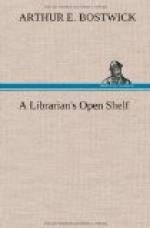It is not the purpose of this paper to discuss whether we have grounds for belief that there is such a thing as a minimum quantity, or atom, of energy, that does not separate into smaller parts, no matter what changes it undergoes. Suffice it to say that there appears to be no a priori absurdity in such an idea. At first sight both matter and energy appear non-molecular in structure. But we have been forced to look upon the gradual growth of a crystal as a step-by-step process, and we may some day, by equally cogent considerations, be forced to regard the gradual increase of energy of an accelerating body as also a step-by-step process, although the discontinuity is as invisible to the eye in the latter case as in the former.
Without following this out any farther, however, the point may be here emphasized that it is hardly possible for one who, like the majority of physicists, regards matter as molecular and energy as a continuum, to hold the same ideas regarding the identity of the two. Efforts to show that definite portions of energy, like definite portions of matter, retain their identity have hitherto been made chiefly on the lines of a demonstration that energy travels by definite and continuous paths in space just as matter does. This is very well, but it would appear to be necessary to supplement it with evidence to show that the lines representing these paths do not form at their intersections continuous blurs that not only forbid any practical attempt at identification on emergence, but make it doubtful whether we can in any true sense call the issuing path identical with the entering one. Otherwise the identity of energy can be admitted to be only that kind of identity that could be preserved by matter if its molecular structure did not exist. One who can admit that this sort of identity is the same sort that can be preserved by molecular matter may be able to hold the identity of energy in the present state of the evidence, but the present attitude of physicists would seem to show that, whether they realize the connection of the two subjects or not, they cannot take this view. In other words, modern views of the identity of matter seem closely connected with modern views of its structure, and the same connection will doubtless hold good for energy.
Regarding the probable success of an attempt to prove that energy has a “structure” analogous to the molecular structure of matter, any prediction would doubtless be rash just now. The writer has been unable, up to the present time, to disprove the proposition, but the subject is one of corresponding importance to that of the whole molecular theory of matter and should not be entered upon lightly.
* * * * *
The writer freely acknowledges at present that the illustrations in the foregoing are badly chosen and some of the statements are too strong, but it still represents essentially his ideas on the subject. No reputable scientific journal would undertake to publish it. The paper was then sent to Prof. J. Willard Gibbs of Yale, and elicited the following letter from him:




